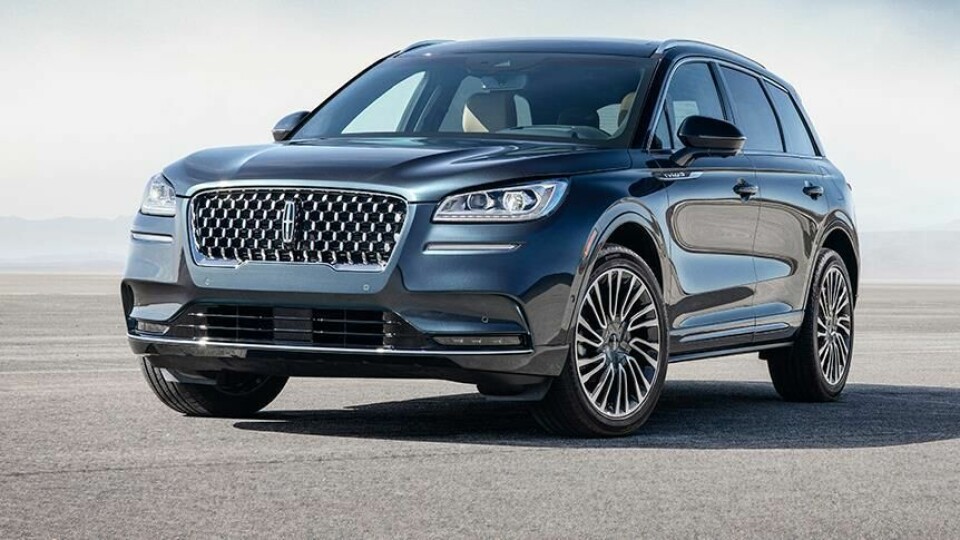
Interior Motives: Lincoln Corsair
A luxurious Lincoln, in spite of its compact dimensions
Lincoln has been working in the C-sector space for over a decade, seeking to bring big-car luxury to a small platform and package. The spacious Lincoln C concept of 2009 explored this theme, and hints of Lincoln interiors to come were found in that car, especially the broad two-tiered instrument panel and the wide, open cabin and panoramic roof; and the experience of the C project has surely informed the bringing of the premium ambience of Lincoln’s larger SUVs into the five-seater Corsair, which completes Lincoln’s latest product line renewal. Though it will be related to the next-generation Ford Escape, a more car-like vehicle (Kuga, in Europe), the Corsair is squarely in the SUV/crossover sector and clearly tied-in with its larger counterparts, the full-size Navigator and mid-size Aviator. It’s no less of a luxurious Lincoln, despite its compact dimensions.
Quiet flight
The ‘quiet flight’ brand strategy, first developed for the Navigator [IM: Autumn 2017] and then continued in the Aviator [IM: Summer 2018], was extended for this compact model codenamed CX483. In the mood board for this theme, four concepts were identified: ‘beauty’, ‘gliding’, ‘human’ and ‘sanctuary’. Although each of these concepts found their own expression, the ‘beauty’ concept was placed at the centre of the design. The Corsair is considered the most athletic and activity-focused model of the new Lincoln range, and so the image of the ballerina – athletic and graceful – dominated early design sketches.
In initial ideations, the ‘S-curve’ design motif, as illustrated by the contour of the ballerina, was established. This can be found on exterior and interior elements: the surfacing of the flanks on the exterior, and on the interior door cards and trim, leading the eye along a graceful curvature which complements the horizontals that are a constituent part of all Lincoln design. “Human hands worked to develop those sculpted S-curves and sides, all of which play off light and movement,” says David Woodhouse, design director during the development of the Corsair (who has since moved to Nissan Design America).
The team focused on an environment balancing calm, capable beauty with being intriguing and expressive; keywords for this included ‘open’, ‘equilibrium’ and ‘sanctuary’. Mood boards [not depicted here] for the project refer to some luxury competitors as having “colder, ‘hands on’ interior environments” which are “dark, foreboding, masculine, complex, more aggressive”, whereas “Lincoln is warm, human – a significant differentiation” with a character expressing “lightness, simplicity, sanctuary, more intuitive”.
“We wanted the customer to experience the themes of ‘calm’ and ‘in control’, but also to have an experience of the Corsair that will be intriguing and innovative,” says Robert Gelardi, interior design manager for the Corsair programme. “We explored various themes, but each time, we returned to the concept of ‘sanctuary’ to verify that we were staying close to our design brief.”
Corsair sketches
Lincoln identified its target customer for this compact model as an ‘enlightened traveller’ – someone who is confident in their path through life, the type of person who celebrates the journey (not just the destination). Such individuals see life as open-ended and rich in experiences, evolving as their journey unfolds.
Although no specific age demographic was identified, “the smallest Lincoln SUV is the most expressive, and significantly, the most youthful – deliberately so in order to draw new and younger clients,” notes Woodhouse.
Older buyers were also on the radar, however, who might not need the size and expansive seating of the Aviator and Navigator; and also urban residents, who might see the Corsair as a luxury vehicle appropriate for the tight manoeuvring and parking demands of the city. “It was not so much a matter of age as it was an approach to life,” adds Robert Gelardi.
Dovetailing nicely into the broader ‘quiet flight’ strategy and traveller theme comes the CX483’s name: while ‘Corsair’ is popularly understood as a synonym for ‘pirate’, it actually derives from the Latin word ‘cursus’, or ‘journey’. And of course, this name is familiar to enthusiasts of the Ford Motor Company, too.
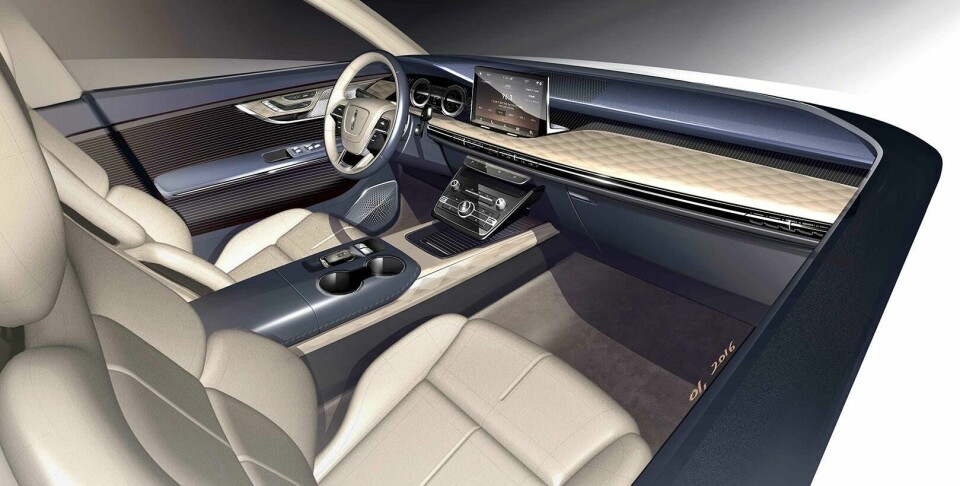
The 2016 theme sketch [above] shows an instrument panel now different in many ways from that of the C concept [below], but some key ideas remain: a relatively uncluttered and open feeling; a pale colour palette; and a focus on connectivity.
C concept
One of Lincoln’s brand themes is ‘relaxed command’, which implies a firm sense of the placement and types of controls but also emphasises creature comforts to match the command experience. Reinforcing this, the IP is the central feature of the interior design, laying out the HMI yet also introducing occupants to the broad panoramas beyond. As the Corsair’s cabin is smaller than the Aviator’s or Navigator’s, it was important to employ strong horizontal elements to draw the eye across the car and out to the horizon. The panorama extends vertically, too, with roof panels taking the view skyward from both the front and rear seats.
“Strong horizontals and layering are the key design characteristics of the IP,” explains Robert Gelardi. “Instead of one monolithic slab, the IP is broken into two planes separated by a distinct horizontal riser. The upper portion of the IP is set back toward the windshield, and the lower portion projects towards the passengers. This lower tier contains the air registers – themselves very horizontal in their design.”
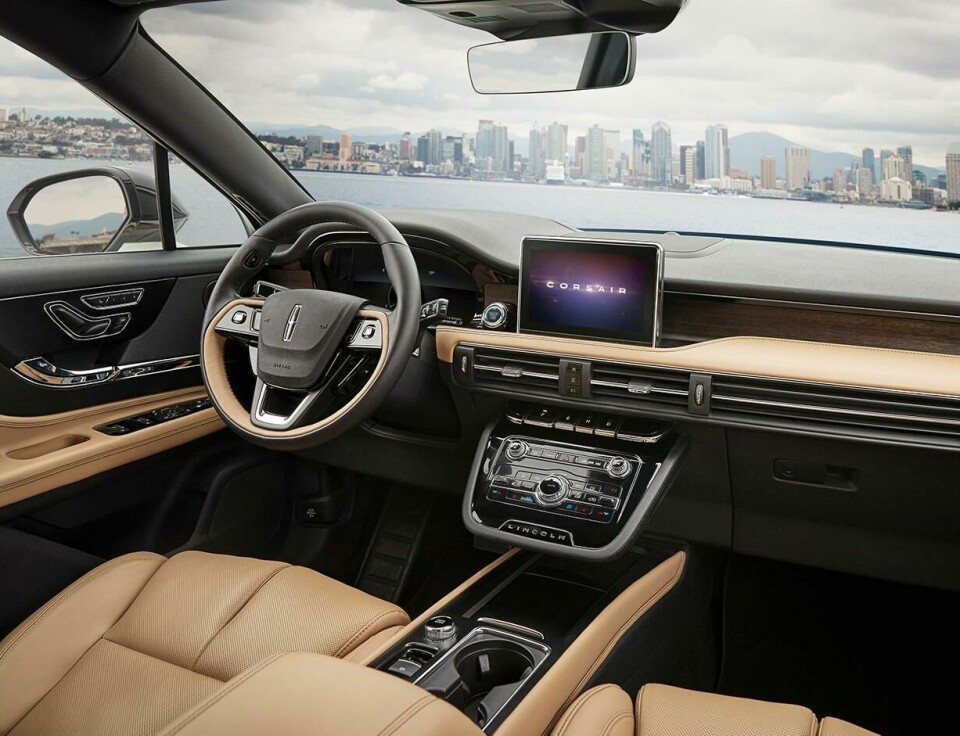
The reduced scale of the Corsair meant a new approach to these horizontal elements was needed. “The Navigator instrument panel is very formal, very horizontal, but also extends straight across,” notes Gelardi. “The instrument panel in the Corsair is also horizontal, but has a lot of curvature, and the way we treat the transition to the sides and doors of the car is quite different, as we have less space to work with.” Reinforcing the layering of the two tiers is the placing of different premium materials on the upper and lower tiers, with the riser between finished in aluminum or wood.
Getting that premium touch was important. At the New York motor show, David Woodhouse pointed out to Car Design News the attention to detail: “some of these elements, like the cantilevered console; or the way we’ve highlighted half of the air registers to play down the volume; or where the material is highlighted around the steering wheel. It’s considering the IP like a theatre design: the upper portions are done in layers and below everything is blacked out, so it looks like the upper part of the dash is floating.”
Gelardi hails the process his team followed. “The Corsair was a wonderful blend of traditional and advanced design techniques,” he says. “We used both analogue and digital sketching, and then moved to clay models and digital models. Although it has been used extensively in other projects, we did not use Gravity Sketch in the development of the Corsair.
“Virtual reality was, however, used extensively in the development of the ‘quiet flight’ design philosophy. It was a wonderful way to mock up various simple forms and test interior components – again modelled very simply – against parameters such as cabin shape, tumblehome, A-pillar rake and other factors. Additionally, the virtual reality development process allowed for our studios around the world to look at different proposals and give their input, thus allowing this project to have a truly global scope. I can’t imagine doing another project without it.
“That said, it was the traditional medium of clay that brought out the design. Lincoln is about beauty and humanity, and that found its expression in the work of our clay modellers who brought out the sculptural aspects of the design. Using VR early in the process to find the right architecture was absolutely essential, but it was the clay models that brought the concepts into their final form.”
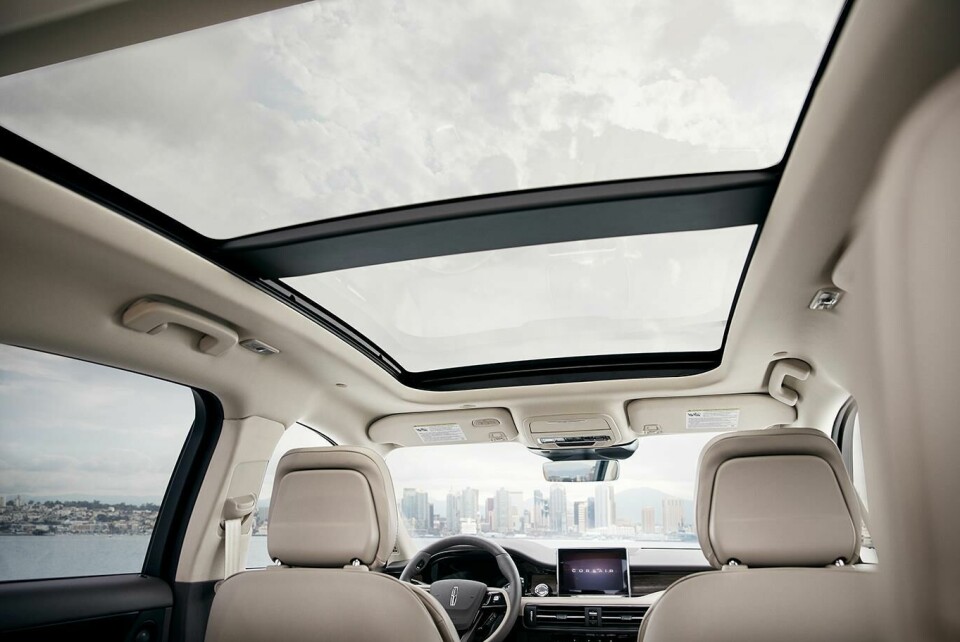
To finish the interior, three new colourways have been developed: Cashew, giving tan with black; a soft grey, Medium Slate; and a bright blue with white. Technology for C-segment cars has, of course, developed since the C concept, and the Corsair is equipped with features such as Co-Pilot 360 (including automatic emergency braking, pedestrian detection, blind spot information, lane-keeping assist and a rear reversing camera); options include automatic emergency steering and braking, and parking assist. A head-up display projects critical information into the driver’s line of sight, and the Lincoln Way app can act as a key, as well as giving access to a suite of concierge services.
In keeping with the ‘sanctuary’ theme, and, of course, the ‘quiet flight’ design philosophy, Lincoln installed a dual-wall dashboard with an air gap, helping to acoustically isolate the cabin from the engine compartment; in addition, an active noise cancelation system further deadens road noise. Of the sounds occupants want – or need – to hear, harsh electronic alerts for situations such as an unbuckled seatbelt or open fuel flap are replaced by six ‘symphonic chimes’ recorded by the Detroit Symphony Orchestra, no less; and a 14-speaker, specially-calibrated Revel audio system is offered. The cabin also incorporates wi-fi, wireless charging for mobile devices, and multiple power outlets.
There was a concern that Lincoln’s acclaimed ‘perfect position seat’, for which more than 50 patents are held, could not be translated to a C-segment vehicle. However, it was, and both the driver and front passenger seats are adjustable in 24 different ways. The rear seats slide by up to six inches and give a 60/40 fold-flat or split-bench option.
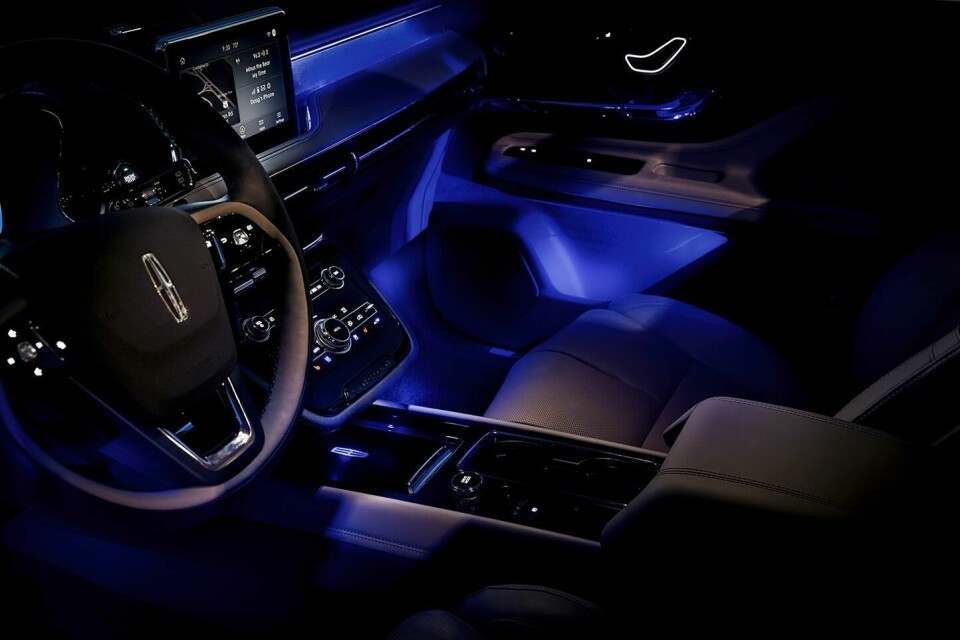
“The easiest job in the world is to make a super-luxury car. The hardest job in the world is doing a price-conscious product,” David Woodhouse told Car Design News at the New York motor show. “We tried to give the Corsair all the same design attention as a Navigator or Aviator, but the price point is really sensitive and all about making the right choices.” Nonetheless, he says that his team was able to make the car they wanted, without too many sacrifices.
Robert Gelardi sums up the project: “The Corsair shows the strength of the ‘quiet flight’ design philosophy and the adaptability of the strategy across the vehicle range. The architecture, the emphasis on the horizontals in the interior, and the generous use of luxurious, sumptuous materials will benefit us as a brand, and bodes well for Lincoln designs of the future.”













